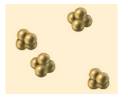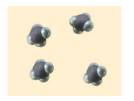
Introductory Chemistry: An Active Learning Approach
6th Edition
ISBN: 9781305079250
Author: Mark S. Cracolice, Ed Peters
Publisher: Cengage Learning
expand_more
expand_more
format_list_bulleted
Concept explainers
Textbook Question
Chapter 2, Problem 2.7TC
Which of the following are compounds, and which are elements?
a) Na2S
b) Br2
c) Potassium hydroxide
d) Fluorine
e) Compound or element

f) Compound or element

Expert Solution & Answer
Trending nowThis is a popular solution!

Students have asked these similar questions
What spectral features allow you to differentiate the product from the starting material?
Use four separate paragraphs for each set of comparisons. You should have one paragraph each devoted to MS, HNMR, CNMR and IR.
2) For MS, the differing masses of molecular ions are a popular starting point. Including a unique fragmentation is important, too.
3) For HNMR, CNMR and IR state the peaks that are different and what makes them different (usually the presence or absence of certain groups). See if you can find two differences (in each set of IR, HNMR and CNMR spectra) due to the presence or absence of a functional group. Include peak locations. Alternatively, you can state a shift of a peak due to a change near a given functional group. Including peak locations for shifted peaks, as well as what these peaks are due to. Ideally, your focus should be on not just identifying the differences but explaining them in terms of functional group changes.
Question 6
What is the major product of the following Diels-Alder reaction?
?
Aldy by day of
A.
H
о
B.
C.
D.
E.
OB
OD
Oc
OE
OA
None
Chapter 2 Solutions
Introductory Chemistry: An Active Learning Approach
Ch. 2 - Consider the photograph and illustrations of table...Ch. 2 - In the left box, draw a particulate-level...Ch. 2 - Classify the following changes as chemical C or...Ch. 2 - Specific gravity is a physical property. Beakers...Ch. 2 - Classify the following as homogenous or...Ch. 2 - Table salt from the beaker on the left in the...Ch. 2 - Which of the following are compounds, and which...Ch. 2 - Prob. 2.8TCCh. 2 - Identify the net electrical force-attraction,...Ch. 2 - aIs the process of boiling water exothermic or...
Ch. 2 - In everyday language, the term conserve usually...Ch. 2 - Write a brief description of the relationships...Ch. 2 - Write a brief description of the relationships...Ch. 2 - Prob. 3CLECh. 2 - Write a brief description of the relationships...Ch. 2 - Prob. 5CLECh. 2 - Prob. 6CLECh. 2 - Prob. 1ECh. 2 - Classify each of the following as macroscopic,...Ch. 2 - Suggest a reason for studying matter at the...Ch. 2 - How does a chemist think about particles that are...Ch. 2 - Using spheres to represent individual atoms,...Ch. 2 - Describe a piece of ice at the particulate level....Ch. 2 - 7.The word pour is commonly used in reference to...Ch. 2 - Prob. 8ECh. 2 - Which of the three states of matter is most easily...Ch. 2 - Compare the volumes occupied by the same sample of...Ch. 2 - Classify each of the following properties as...Ch. 2 - Classify the italicized property as chemical or...Ch. 2 - Which among the following are physical changes? a...Ch. 2 - Classify each of the following changes as chemical...Ch. 2 - Is the change illustrated below a physical change...Ch. 2 - Is the change in the illustration below a physical...Ch. 2 - Diamonds and graphite are two forms of carbon....Ch. 2 - Aspirin is a pure substance. If you had the choice...Ch. 2 - The substance in the glass below is from a kitchen...Ch. 2 - Are the contents of the bottle in the picture...Ch. 2 - Which of the following particulate illustrations...Ch. 2 - Which of the following particulate illustrations...Ch. 2 - Which of the following are pure substances and...Ch. 2 - Which of the substances below are pure and which...Ch. 2 - Apart from food, list five things in your home...Ch. 2 - Can the terms homogeneous and heterogeneous be...Ch. 2 - Which items in the following list are...Ch. 2 - Classify each of the following mixtures as either...Ch. 2 - Some ice cubes are homogeneous and some are...Ch. 2 - The freshly polished brass cylinder in the picture...Ch. 2 - Draw a particulate-level sketch of a heterogeneous...Ch. 2 - Draw a particulate-level sketch of a homogeneous...Ch. 2 - Suppose someone emptied ball bearings into a...Ch. 2 - Suggest at least two ways to separate ball...Ch. 2 - Prob. 35ECh. 2 - You receive a mixture of table salt and sand and...Ch. 2 - Classify the following as compounds or elements: a...Ch. 2 - Classify each of the following pure substances as...Ch. 2 - Which of the following are elements, and which are...Ch. 2 - Classify each of the following pure substances as...Ch. 2 - Classify each substance in the illustrations below...Ch. 2 - Does each of the particulate-level models below...Ch. 2 - a Which of the following substances would you...Ch. 2 - a Which of the following substances would you...Ch. 2 - Metal A dissolves in nitric acid solution. You can...Ch. 2 - A white, crystalline material that looks like...Ch. 2 - Questions 47 and 48: Samples of matter may be...Ch. 2 - Questions 47 and 48: Samples of matter may be...Ch. 2 - What is the main difference between electrostatic...Ch. 2 - Identify the net electrostatic force attraction,...Ch. 2 - Identify the reactants and products in the...Ch. 2 - In the following equation for a chemical reaction,...Ch. 2 - In the equation Ni+Cu(NO3)2Ni(NO3)2+Cu, which of...Ch. 2 - Write the formulas of the elements that are...Ch. 2 - Prob. 55ECh. 2 - Classify each of the following changes as...Ch. 2 - As a child plays on a swing, at what point in her...Ch. 2 - A bicycle accelerates from 5 miles per hour to 15...Ch. 2 - After solid limestone is heated, the rock that...Ch. 2 - Before electronic flashes were commonly used in...Ch. 2 - The photograph below shows a beaker of water and a...Ch. 2 - Prob. 62ECh. 2 - Prob. 63ECh. 2 - Prob. 64ECh. 2 - Distinguish precisely and in scientific terms the...Ch. 2 - Prob. 66ECh. 2 - A natural-food store advertises that no chemicals...Ch. 2 - Prob. 68ECh. 2 - Name some pure substances you have used today.Ch. 2 - How many homogeneous substances can you reach...Ch. 2 - Which of the following can be pure substances:...Ch. 2 - Can you have a mixture of two elements as well as...Ch. 2 - Can you have more than one compound made of the...Ch. 2 - Rainwater comes from the oceans. Is rainwater more...Ch. 2 - Prob. 75ECh. 2 - Prob. 76ECh. 2 - Consider the sample of matter in the illustration...Ch. 2 - A particulate-level illustration of the reaction...Ch. 2 - Prob. 79ECh. 2 - Prob. 80ECh. 2 - Prob. 81ECh. 2 - Prob. 82ECh. 2 - Particles in the illustration below undergo a...Ch. 2 - Prob. 84E
Knowledge Booster
Learn more about
Need a deep-dive on the concept behind this application? Look no further. Learn more about this topic, chemistry and related others by exploring similar questions and additional content below.Similar questions
- In the solid state, oxalic acid occurs as a dihydrate with the formula H2C2O4 C+2H2O. Use this formula to calculate the formula weight of oxalic acid. Use the calculated formula weight and the number of moles (0.00504mol) of oxalic acid in each titrated unknown sample recorded in Table 6.4 to calculate the number of grams of pure oxalic acid dihydrate contained in each titrated unknown sample.arrow_forward1. Consider a pair of elements with 2p and 4p valence orbitals (e.g., N and Se). Draw their (2p and 4p AO's) radial probability plots, and sketch their angular profiles. Then, consider these orbitals from the two atoms forming a homonuclear л-bond. Which element would have a stronger bond, and why? (4 points)arrow_forwardWrite the reaction and show the mechanism of the reaction. Include the mechanism for formation of the NO2+ 2. Explain, using resonance structures, why the meta isomer is formed. Draw possible resonance structures for ortho, meta and para.arrow_forward
- Nonearrow_forward3. A molecular form of "dicarbon", C2, can be generated in gas phase. Its bond dissociation energy has been determined at 599 kJ/mol. Use molecular orbital theory to explain why energy of dissociation for C₂+ is 513 kJ/mol, and that for C2² is 818 kJ/mol. (10 points)arrow_forward9.73 g of lead(IV) chloride contains enough Cl- ions to make ____ g of magnesium chloride.arrow_forward
- 6. a) C2's. Phosphorus pentafluoride PF5 belongs to D3h symmetry group. Draw the structure of the molecule, identify principal axis of rotation and perpendicular (4 points) b) assume that the principal axis of rotation is aligned with z axis, assign symmetry labels (such as a1, b2, etc.) to the following atomic orbitals of the P atom. (character table for this group is included in the Supplemental material). 3s 3pz (6 points) 3dz²arrow_forward2. Construct Lewis-dot structures, and draw VESPR models for the ions listed below. a) SiF5 (4 points) b) IOF4 (4 points)arrow_forward5. Complex anion [AuCl2]¯ belongs to Doh symmetry point group. What is the shape of this ion? (4 points)arrow_forward
arrow_back_ios
SEE MORE QUESTIONS
arrow_forward_ios
Recommended textbooks for you
 Introductory Chemistry: An Active Learning Approa...ChemistryISBN:9781305079250Author:Mark S. Cracolice, Ed PetersPublisher:Cengage LearningChemistry: Matter and ChangeChemistryISBN:9780078746376Author:Dinah Zike, Laurel Dingrando, Nicholas Hainen, Cheryl WistromPublisher:Glencoe/McGraw-Hill School Pub Co
Introductory Chemistry: An Active Learning Approa...ChemistryISBN:9781305079250Author:Mark S. Cracolice, Ed PetersPublisher:Cengage LearningChemistry: Matter and ChangeChemistryISBN:9780078746376Author:Dinah Zike, Laurel Dingrando, Nicholas Hainen, Cheryl WistromPublisher:Glencoe/McGraw-Hill School Pub Co Chemistry & Chemical ReactivityChemistryISBN:9781133949640Author:John C. Kotz, Paul M. Treichel, John Townsend, David TreichelPublisher:Cengage Learning
Chemistry & Chemical ReactivityChemistryISBN:9781133949640Author:John C. Kotz, Paul M. Treichel, John Townsend, David TreichelPublisher:Cengage Learning Chemistry by OpenStax (2015-05-04)ChemistryISBN:9781938168390Author:Klaus Theopold, Richard H Langley, Paul Flowers, William R. Robinson, Mark BlaserPublisher:OpenStax
Chemistry by OpenStax (2015-05-04)ChemistryISBN:9781938168390Author:Klaus Theopold, Richard H Langley, Paul Flowers, William R. Robinson, Mark BlaserPublisher:OpenStax Chemistry: Principles and ReactionsChemistryISBN:9781305079373Author:William L. Masterton, Cecile N. HurleyPublisher:Cengage Learning
Chemistry: Principles and ReactionsChemistryISBN:9781305079373Author:William L. Masterton, Cecile N. HurleyPublisher:Cengage Learning

Introductory Chemistry: An Active Learning Approa...
Chemistry
ISBN:9781305079250
Author:Mark S. Cracolice, Ed Peters
Publisher:Cengage Learning

Chemistry: Matter and Change
Chemistry
ISBN:9780078746376
Author:Dinah Zike, Laurel Dingrando, Nicholas Hainen, Cheryl Wistrom
Publisher:Glencoe/McGraw-Hill School Pub Co

Chemistry & Chemical Reactivity
Chemistry
ISBN:9781133949640
Author:John C. Kotz, Paul M. Treichel, John Townsend, David Treichel
Publisher:Cengage Learning

Chemistry by OpenStax (2015-05-04)
Chemistry
ISBN:9781938168390
Author:Klaus Theopold, Richard H Langley, Paul Flowers, William R. Robinson, Mark Blaser
Publisher:OpenStax

Chemistry: Principles and Reactions
Chemistry
ISBN:9781305079373
Author:William L. Masterton, Cecile N. Hurley
Publisher:Cengage Learning
Types of Matter: Elements, Compounds and Mixtures; Author: Professor Dave Explains;https://www.youtube.com/watch?v=dggHWvFJ8Xs;License: Standard YouTube License, CC-BY